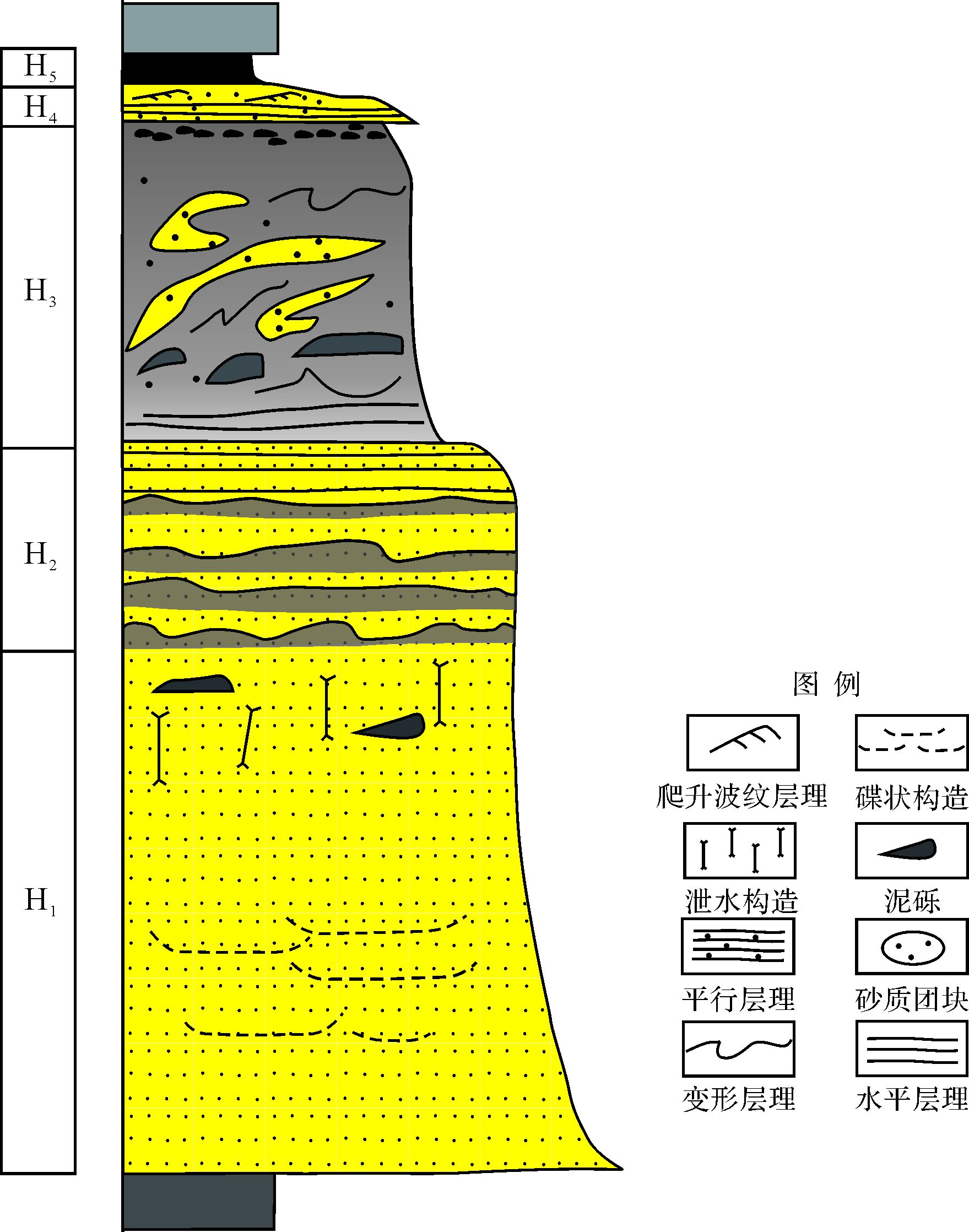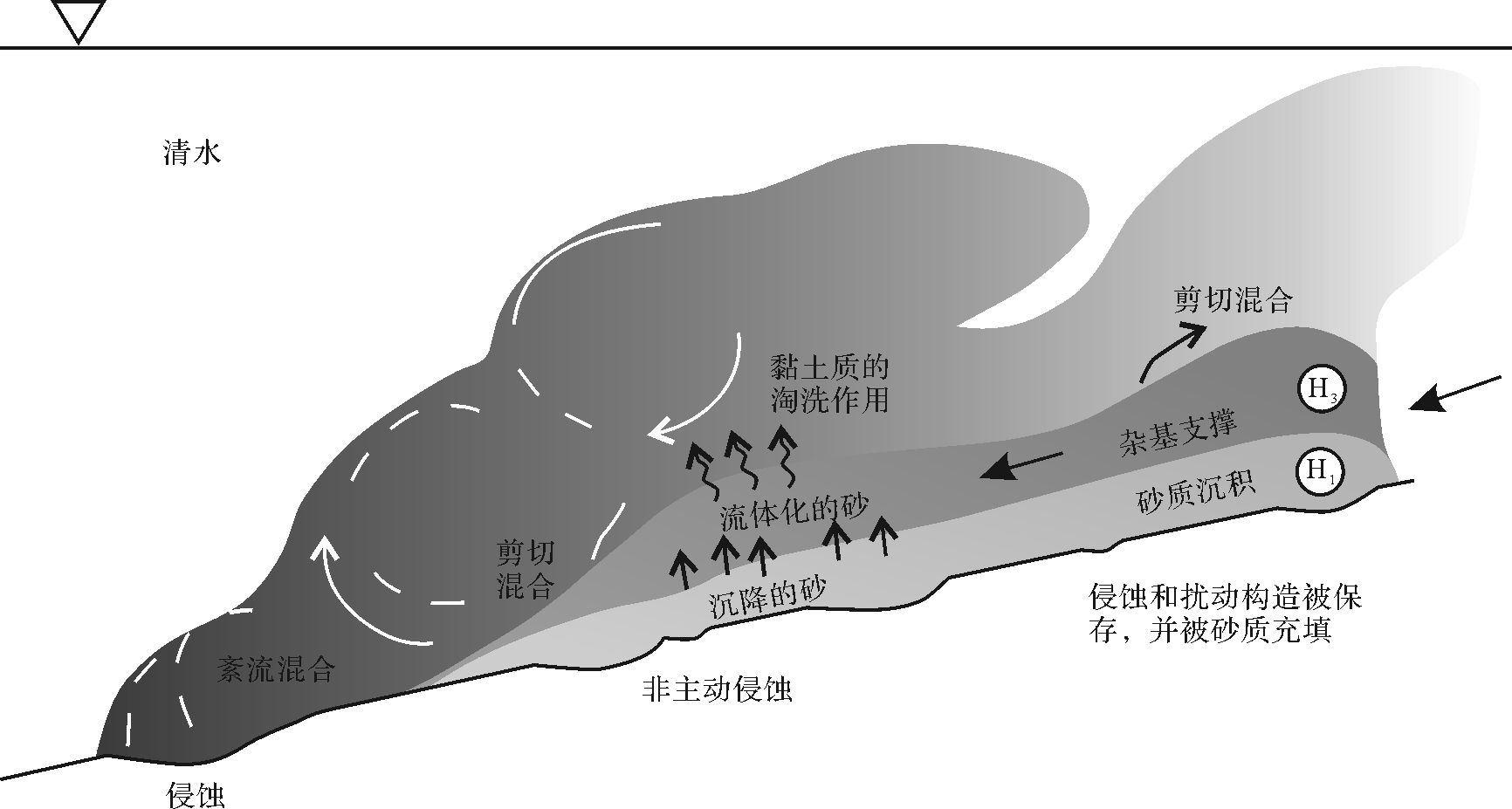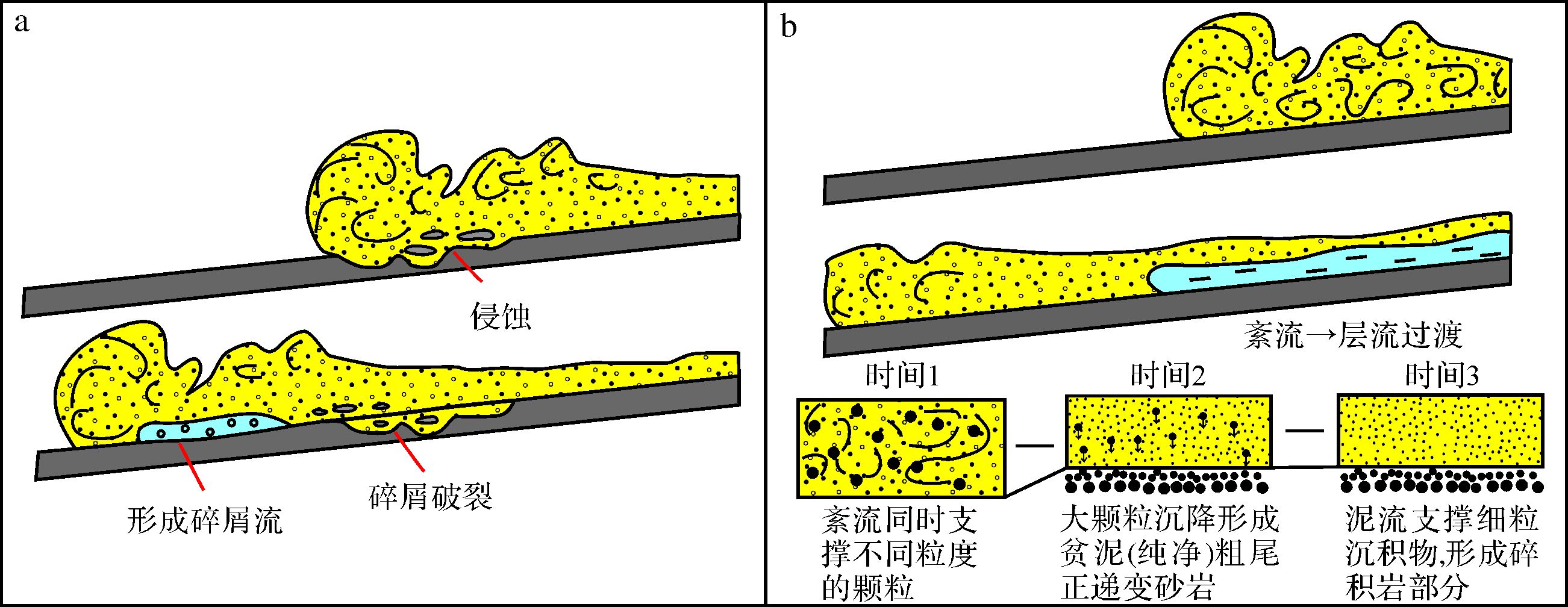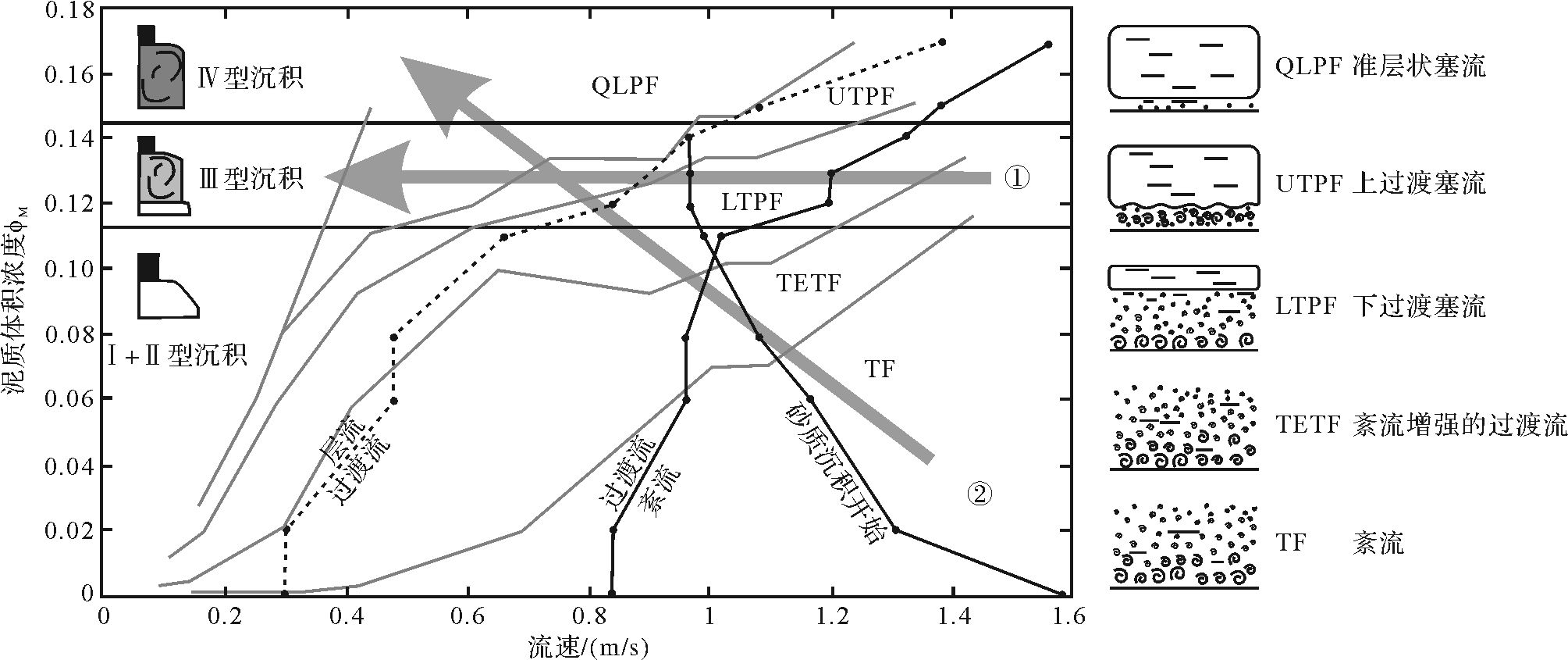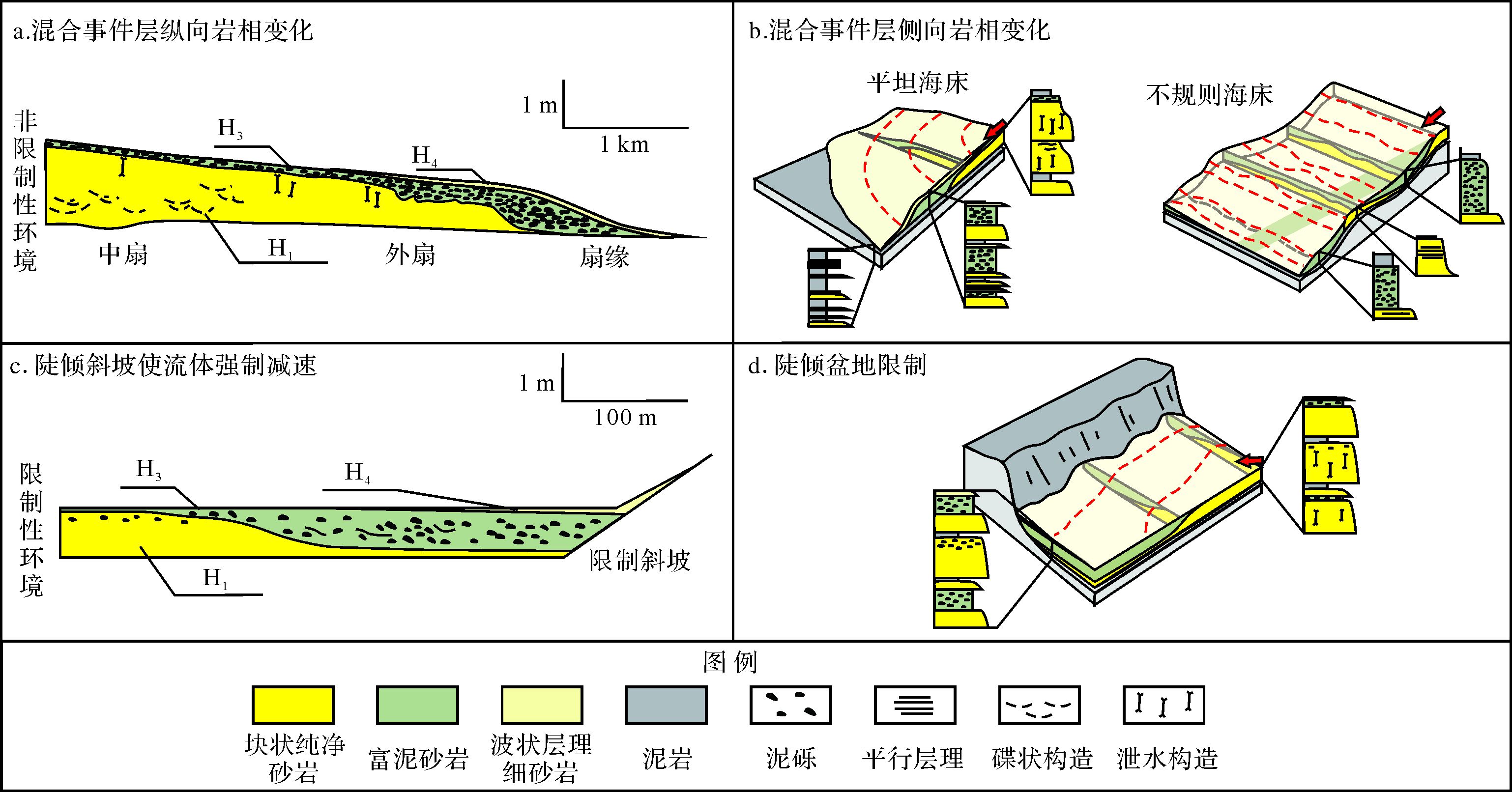扩展功能
文章信息
- 谈明轩, 朱筱敏, 耿名扬, 刘常妮
- TAN MingXuan, ZHU XiaoMin, GENG MingYang, LIU ChangNi
- 沉积物重力流流体转化沉积-混合事件层
- The Flow Transforming Deposits of Sedimentary Gravity Flow-Hybrid Event Bed
- 沉积学报, 2016, 34(6): 1108-1119
- ACTA SEDIMENTOLOGICA SINCA, 2016, 34(6): 1108-1119
- 10.14027/j.cnki.cjxb.2016.06.009
-
文章历史
- 收稿日期:2015-12-14
- 收修改稿日期: 2016-02-17
2. 中国石油大学(北京)油气资源与探测国家重点实验室 北京 102249 ;
3. 中海油研究总院 北京 100028
2. State Key Laboratory of Petroleum Resource and Prospecting, Beijing 102249, China;
3. CNOOC Research Institute, Beijing 100028, China
自Kuenen和Migliorini于1950年联合发表“作为递变层理成因的浊流”一文以来,沉积物重力流始终是沉积学的研究热点[1]。Bouma(1962)所建立的经典浊积岩Bouma序列成为目前沿用最广泛的浊流沉积识别标志[2]。半个世纪以来,浊流理论体系逐渐丰富和完善。Stow和Shanmugam(1980)对Bouma序列的Tc-Te段的岩相精细描述,提出细粒浊积岩的沉积序列[3]。Lowe(1979,1982)按照沉积物的粒度、颗粒浓度以及沉积物支撑机制将浊流划分为3类:低密度浊流、砂质高密度浊流和砾质高密度浊流[4-5]。Massari(1984)、Mutti(2003)进一步细化了高密度浊积岩的沉积序列[6-7]。Postma(1988)借助水槽实验解释高密度浊流层内漂浮碎屑的成因[8]。Sohn(1997)提出5种典型的牵引毯沉积类型[9],Cartigny等(2013)在水槽实验的基础上对牵引毯的类型进行简化[10]。Postma等(2009,2014a,2014b)进一步探寻浊流的流态,尝试利用超临界流水跃的现象解释高密度浊积岩的岩相发育特征[11-13]。然而有些沉积学家过分夸大了浊流理论的适用范围,尝试利用浊流理论解释所有重力流的沉积现象,使浊流理论逐渐达到瓶颈期。
与此同时,水下碎屑流理论体系的进展也驱动着以Shanmugam、Mulder和Talling为代表的沉积学家对一些特殊的沉积现象(如块状砂岩、漂浮状碎屑和反递变层理等)展开深入研究[14-20]。其中,Shanmugam[21]认为流变学理论无法解释高密度浊流的成因机理,故而把高密度浊流割裂为砂质碎屑流、浊流两部分。他还对Bouma序列的合理性提出了质疑,指出只有Ta段才符合浊流的紊流沉积特征,紊流和层流之间不存在过渡性流体[15, 22-23]。近年来,他甚至提出砂质碎屑流理论完全可以用来解释Bouma序列所有层段的成因[24]。但是,这种相对偏执的理论认识似乎也过于绝对。
随着国内外学者开始从水动力学角度探究重力流的沉积特征,很多人逐渐意识到不能形而上地将大多数重力流划分为浊流和碎屑流两方面,二者之间实质上存在连续性变化的过程[25-27]。起初,Fisher(1983)、Smith和Lowe(1991)提出“流体转化”(Flow Transformation)的概念用以表述火山泥石流的流体性质变化过程,二十世纪末这个概念被引入到水下重力流的研究中[28-29]。过去几十年里,许多学者借用水槽实验、数值模拟的方法对其流体转化机理不断探索与求证,取得了丰硕的成果[30-36]。然而,能够完整反映流体转化的露头沉积却是极为少见的[37]。另外,在过去露头构型剖析过程中,研究人员只是在不同观测点将相对孤立的沉积现象进行对比,以期获取流体转化的间接证据[38]。但是,他们却忽略了单次重力流在同一位置存在多种沉积组合,而这种沉积组合在空间上又富有变化[39]。近年来,随着大洋钻探计划(IODP)的深入实施以及激光扫描技术(LIDAR)在数字露头中广泛应用,使得深水柱样精细对比与野外露头精细刻画成为可能,也促使了与流体转化相关的混合事件层的发现。
混合事件层(Hybrid Event Bed,简称HED),又称混合层(Hybrid Bed),其概念首次由Haughton等(2009)提出[39]。混合事件层是由同期重力流事件沉积形成的、成因上存在相互关联的浊积岩和碎积岩(Debrites)组合,本质上是在流体转化作用下单次重力流能够在不同时间内在垂向上形成浊积岩、碎积岩的沉积组合。单次重力流在流体转化过程中流变学性质发生改变,因此其沉积物在垂向上表现为岩性、结构及沉积构造突变。当然,多期重力流事件通过流体转化形成的沉积产物也可表现为多期叠置的特征,同时在空间上具备相当的规模。混合事件层在深水沉积中广泛分布[39-41],并对于深水储层非均质性以及有利岩性圈闭分布具有重要的影响[42-44]。
1 混合事件层的研究历史混合事件层概念的提出主要源自于Bouma序列在应用研究中的局限性。Ricci Lucchi et al.[45-46]在多个典型深水沉积露头中发现了质纯砂岩、杂砂岩和泥岩的三重结构,然而Bouma序列不能完整地涵盖这种三重结构,故将其定名为“三明治层”(Sandwiched beds),从此成为了混合层研究的开端。Sohn[47]在韩国浦项盆地中新世扇三角洲沉积中发现了浊流与碎屑流沉积的特殊叠置样式,他认为这种样式是无滑水作用的碎屑流(Nonhydroplaning debris flow)流体转化沉积所致。McCaffrey et al.[42]在解剖法国西南部Annot深水露头中也发现了这种“三明治层”沉积。Haughton et al.[43]在北海盆地上侏罗统海底扇研究过程中,将扇体中杂砂岩部分解释为“相关联的碎积岩”(Linked Debrites)。Talling et al.(2004,2007b,2007c)、Amy et al.(2005,2006a)把意大利Marnoso Arenacea前陆盆地Marnoso Arenacea组中类似的沉积物称之为“联生碎积岩”(Co-genetic Debrites)[48-52]。Talling et al.(2007a)首次报道了西北非近海中单次流动距离达1500km的混合重力流,这种重力流沉积中发育“联生碎积岩”,并认为这种流体是由浊流转化而来[40]。这项成果在顶级学术刊物《Nature》刊出后,即受到沉积学界广泛关注。Haughton et al.(2009)、Talling(2013b)综合多地深水沉积的相关研究,提出了混合事件层的“五段式”正韵律沉积序列,进一步丰富了混合重力流的转化过程,对混合事件层的沉积序列和形成环境进行深入研究[39, 41]。Talling et al.[53]总结近几十年重力流相关成果,提出浊流所产生的紊流抑制作用(Turbulence Damping)是促进流体转化、形成混合事件层的重要原因。
近年来与混合层相关的沉积物理模拟研究同样成果卓著。Amy et al.[54]在不同砂泥含量流体的静置悬浮实验中证实了细微泥质含量变化对形成混合层的重要影响。Sumner et al.[55]通过不同黏土含量重力流的水槽实验对多种混合层的成因进行了验证。Baas et al.[56-57]将不同黏土含量流体定义了多种过渡流类型,重点研究了其垂向流变学结构,据此对浊流减速形成混合层的可能性展开讨论。
2 混合事件层的沉积序列混合层沉积反映了单次碎屑流或浊流转化所形成的沉积物,因此具有十分独特的沉积组合。Haughton等(2009)、Talling(2013b)提出了混合层沉积序列,对不同层段进行岩相描述和解释[39, 41]。整体上混合层表现为典型的正韵律特征,与Bouma层序颇为相似,主体上由五段式组成(图 1)。然而浊流部分以悬浮递变沉积为主,而碎屑流部分则以块状冻结沉积为主,因此单次流体所形成的混合层其内部层段通常存在明显的岩性突变界面。
H1段通常为相对纯净的中细砂岩(杂基含量一般小于5%),分选相对较好,具有块状层理或者正递变层理,偶见漂浮泥砾,有时可见泄水构造、碟状构造等同生变形构造,单层沉积厚度为0.1~1.0 m[41, 43]。纯净砂岩段一般是由流体转化所成的浊流沉积,因此岩相特征类似于Bouma层序Ta段。此外,中等黏度碎屑流或弱黏度碎屑流也能形成质纯砂岩H1段,但其沉积厚度较薄[41, 50, 55, 58]。
2.2 条带状砂岩段(H2)H2段通常为明暗相间的砂岩或砂泥岩互层。互层砂泥岩中同生剪切变形较为发育,整体上呈波浪起伏的条带状[59-60],其厚度通常为0.01~0.5 m[41]。其中,暗色部分岩性为泥质粉砂岩、粉砂质泥岩,黏土矿物、云母类矿物以及含量较高的碳质碎屑,以杂基支撑为主,成层性较差[61]。而浅色部分则是相对纯净的细砂岩、粉砂岩,泥质含量较低,底部呈不规则接触,顶部则为突变接触[39, 59, 62]。
H2段的确定为浊流与碎屑流转化过程中过渡性流体的存在提供了可能性。Lowe等(2000)、Blackbourn等(2000)最初借用化工术语“浆状流”(Slurry Flow)对具有过渡流变学性质的重力流进行了阐释[59, 61]。Lowe等(2000)也尝试用过渡性流体的周期性沉积过程来解释这种互层现象[59],Baas等(2011)则认为是这种流体对下伏砂岩层冲刷混杂沉积所致。其中,条带状起伏特征可能与紊流所产生的Kelvin-Helmholtz不稳性波效应有关[57, 63]。
2.3 黏性碎积岩段(H3)黏性碎积岩段(H3)主要为(黏土)杂基支撑细砂岩、细粒杂砂岩,甚至细砂质泥岩,杂基含量相对较高(一般大于10%)[41]。不同地区发现的混合层中H3段岩相特征是存在差异的,大体可分为三种类型。一种是富含有机质的块状杂砂岩,一种是富含粒度大小不一的泥砾、泥岩撕裂屑或砂质团块的杂砂岩,另外一种是不含泥质碎屑的块状杂砂岩、砂质泥岩。三种具有不同岩相特征的黏性碎积岩厚度变化范围较大,平均厚度为0.2m,实质上反映了多种混合层的发育机制[39, 43]。H3段常为黏性碎屑流块状冻结沉积而成,因而其在结构上分选相对较差。
2.4 波纹层理段(H4)和块状泥岩段(H5)H4段主要为粉细砂岩,具有波状交错层理、爬升波纹层理及水平层理,沉积厚度相对较薄。H4段主要由低密度浊流向牵引流转化过程中沉积所成。最顶部为块状泥岩段(H5),一般由泥质颗粒悬浮沉积所成。
总而言之,典型混合层沉积序列纯净砂岩段(H1)对应Bouma序列底部递变层段(Ta),波状层理段(H4)对应流水纹层段(Tc)和上平行纹层段(Td),块状泥岩段(H5)对应深水泥岩段(Te)。然而条带状砂岩段(H2)与黏性碎积岩段(H3)的发育反映了不同流体转化过程中表现出的过渡性特征,也是混合事件层序列与Bouma序列最为明显的差异。
通常情况下,混合层沉积序列发育不完整[64]。其中H1段、H3段和H5段垂向组合较为常见,这三种层段的常规组合成为了混合事件沉积的主要识别标志。H4段则是间或发育,而H2段就更为少见。笔者在观察乍得Bongor盆地北斜坡带下白垩统Prosopis组岩芯时发现了具有不完整沉积序列的混合事件层(图 2)。通过沉积相综合分析表明,该混合层沉积主要发育于湖底扇中扇前缘微相。
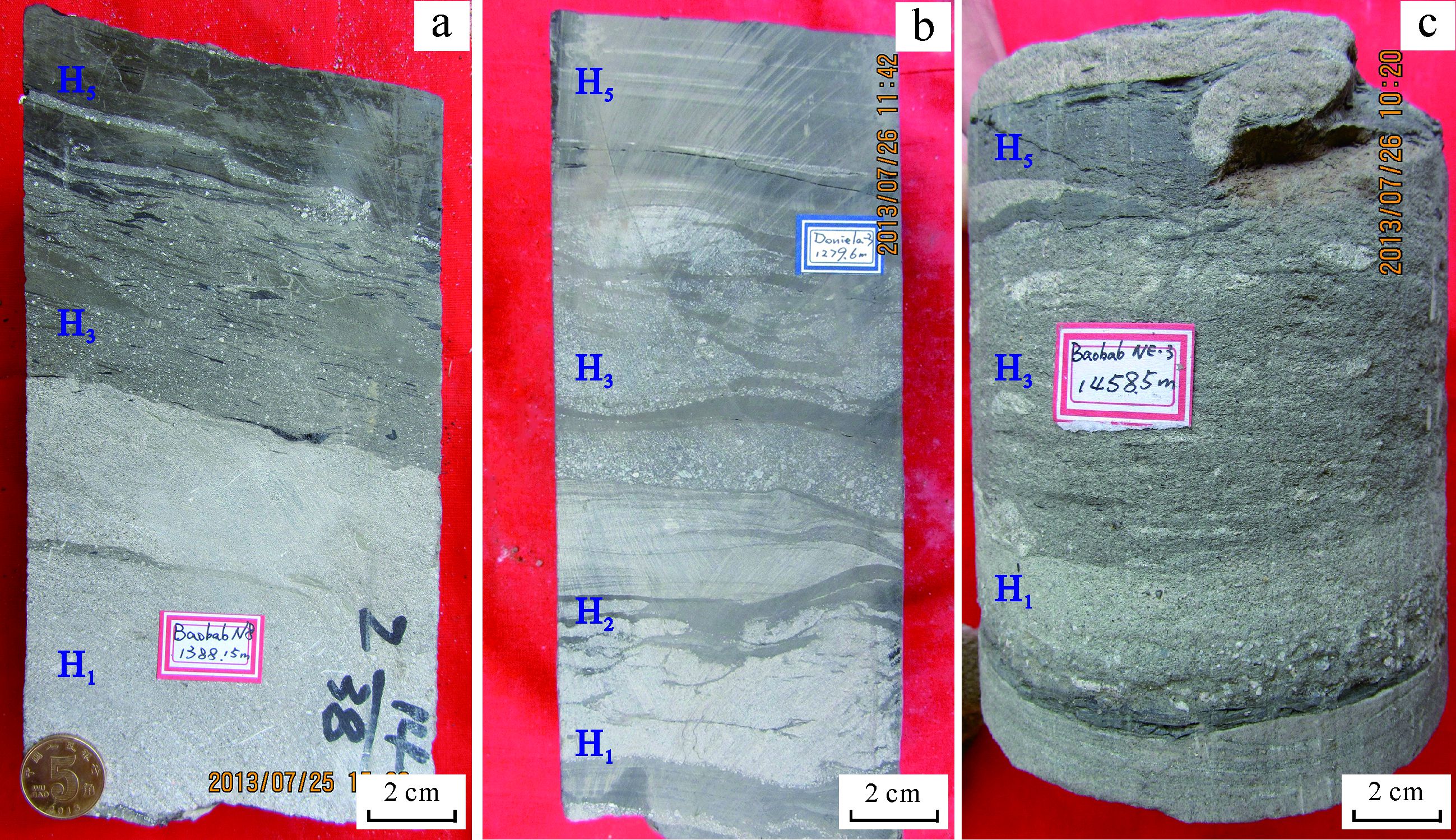
|
| 图 2 乍得Bongor盆地北部斜坡带下白垩统Prosopis组典型混合事件层岩芯照片 a. H1.浅灰色块状细砂岩,H3.灰色泥质粉砂岩,细小的泥砾、泥岩撕裂屑及砂质碎屑呈漂浮状分布,H5.灰黑色块状质纯泥岩,Baobab N8井,Prosopis组,1 388.15 m;b. H1.浅灰色块状细砂岩,见碟状构造,H2.砂岩与泥岩互层呈条带状分布,H3.灰色泥质粉砂岩,毛刺状泥砾、砂质碎屑呈漂浮状分布,H5.深灰色粉砂质泥岩,水平层理发育,Daniela-3井,Prosopis组,1 279.6 m;c. H1.灰色粗尾正粒序中细砂岩,H3.灰色泥质粉砂岩,见砂质团块成层分布,H5.深灰色块状泥岩,Baobab NE-3井,Prosopis组,1 458.5 m。 Figure 2 Typical core photographs of hybrid event beds in the Lower Cretaceous Prosopis Formation of northern slope belt in Bongor Basin,Chad |
混合事件层的形成与碎屑流和浊流相互转化有关。最近十年,诸多学者对于混合层成因机制进行了深入研究,取得了丰硕的成果。总的来说,混合层的形成既可以由单次碎屑流转化形成,也可以由单次浊流转化形成[43-44, 55]。
3.1 单次碎屑流的流体转化在深水沉积环境中,水下碎屑流在流动过程中不断稀释,从而在其上部形成浊流[40, 65-67]。后形成的浊流往往比碎屑流的流速更快,在流动中超越了初始碎屑流,在其前端率先产生沉积,因此最终在相对远源的深水盆地中形成混合层。
实际上,碎屑流的流体转化是一个极其复杂的过程。Breien等(2010)通过水槽实验证实了中-低黏土含量碎屑流在水下运动中其体部存在流体化(Fluidization)过程,使其具备了长距离运动的能力[58]。这种流体头部为紊流部分,体部由于剪切混合作用(shear mixing)呈流体化,尾部仍为层流部分(图 3)。在流体化作用的影响下,其体部的泥质沉积物不断经历淘洗转换向高密度浊流转变,从而沉积形成块状砂岩(即H1段)[41]。随着流体的减速,尾部黏性碎屑流杂基支撑的部分在纯净砂岩之上形成黏性碎屑流沉积(即H3段)。
此外,某些弱黏性碎屑流突然减速、甚至流体已经停止运动依旧可能率先沉积形成薄层纯净砂岩,即晚期沉降现象(Late-stage Settling)。这种弱黏性碎屑流中的颗粒受到了紊流、黏土基质、浮力等多种支撑机制综合作用。当碎屑流突然减速,紊流支撑能力随即迅速衰减。由于碎屑流中黏土基质产生的屈服强度及浮力作用依然提供部分向上支撑力,使砂质颗粒不能迅速沉降下来,颗粒沉积存在一定的滞后性,从而产生了晚期沉降的现象。这种晚期沉降现象使碎屑流中不同粒度的颗粒产生沉积分层的现象,也是混合层的重要成因之一[32, 55]。
3.2 单次经典浊流(涌浪型浊流)的流体转化前人在研究中发现与单次浊流相关的流体转化是混合事件层形成最为普遍的成因[39, 48]。不同的浊流转化现象均与紊流抑制作用相关:①浊流冲刷下伏泥岩,其对于紊流抑制作用增强,泥质颗粒在局部聚集形成次级碎屑流。流速较快的浊流率先沉积,而后碎屑流沉积形成混合层(图 4a)[42-44, 68-70];②浊流减速,其紊流支撑能力减弱。在低速状态下,泥质颗粒对于紊流抑制作用变得更为明显,致使浊流性质开始发生变化,从而在浊流尾部形成黏性碎屑流[63]。浊流在前,碎屑流在后,故而浊流先沉积、碎屑流后沉积形成了混合层沉积(图 4b)[41, 57, 71]。
Baas等(2009)在水槽实验中记录了不同高岭石含量的重力流水下流动过程,定义了5种类型的重力流:1、紊流(TF);2、紊流加强的过渡流(TETF);3、下过渡塞流(LTPF);4、上过渡塞流(UTPF);5、准层状塞流(QLPF)(图 5)。Sumner等(2009)在此基础上发现了4种不同类型的沉积,其中类型Ⅱ和类型Ⅲ为混合层沉积[55]。因此他们认定在浊流形成碎屑流之前,首先经历了过渡性流体阶段。然而,笔者认为这种解释忽略了两相混合流体在同一位置沉积具有先后性的特征。这4种不同类型的沉积实质上反映了同一位置不同混合层部分形成时的流体性质,因此该研究实质上是为混合层的成因解释提供了有利的依据。
初始浊流侵蚀下伏泥岩,浊流中泥质含量不断增高,从而使得浊流不断向层流转化,形成混合事件层(Ⅱ、Ⅲ型沉积)(图 5箭头②)。初始浊流不侵蚀发育泥岩,即浊流中泥质含量不变的情况下,随着浊流缓慢减速,浊流紊流支撑能力逐渐减弱,形成混合层(Ⅲ型沉积)(图 5箭头①)。
混合层形成也可能与深水浊流的改道有关。斜坡浊流水道改道或浊流流经水道-舌状体过渡区,限制性浊流向非限制性浊流转变,线性流动形式向平面喷流形式转变,进而产生水跃、侵蚀下伏海底泥岩,由超临界浊流向亚临界浊流转变,从而形成混合层沉积[13, 72]。
3.3 单次异重流(持续型浊流)的流体转化异重流是一种与河口相连、密度大于周围水体(湖泊或海洋)沿水底流动的负浮力流体[73-75]。异重流本质上是一种持续型浊流,在流动过程中也具有向碎屑流转化的可能性。尽管其流体规模、长距离流动的能力及流体转化机理目前仍然存在较大的争议[18, 44, 76],然而在应用研究中还是不能忽略这种可能性。
Girard等(2012)在研究利比亚Murzuq盆地奥陶系异重岩露头时发现了混合事件层沉积,同时认为这种沉积与异重流增强阶段侵蚀下伏泥岩相关[77]。这也进一步说明异重流的流体转化与涌浪型浊流具有相似性。海洋异重流中颗粒间充满淡水,密度的差异会使异重流在远端产生上浮现象(Loft)。这种上浮现象使得异重流产生分层效应[73, 78-79]。其下部为紊流性质、颗粒较粗的砂质浊流,上部为层流性质、泥质含量更高、粒度较细的黏性碎屑流,因此能够形成由同期异重流所形成的混合层[80-81]。
笔者认为这种分层效应实质反映的是异重流中上浮力对于流体转化的贡献,促使部分异重岩垂向呈现出典型的“三明治”结构:①异重流底床载荷和悬浮载荷沉积;②上浮韵律沉积;③半远洋泥质沉积。因此,这种三重结构可以重新解释为异重流形成的混合层沉积(图 6)。
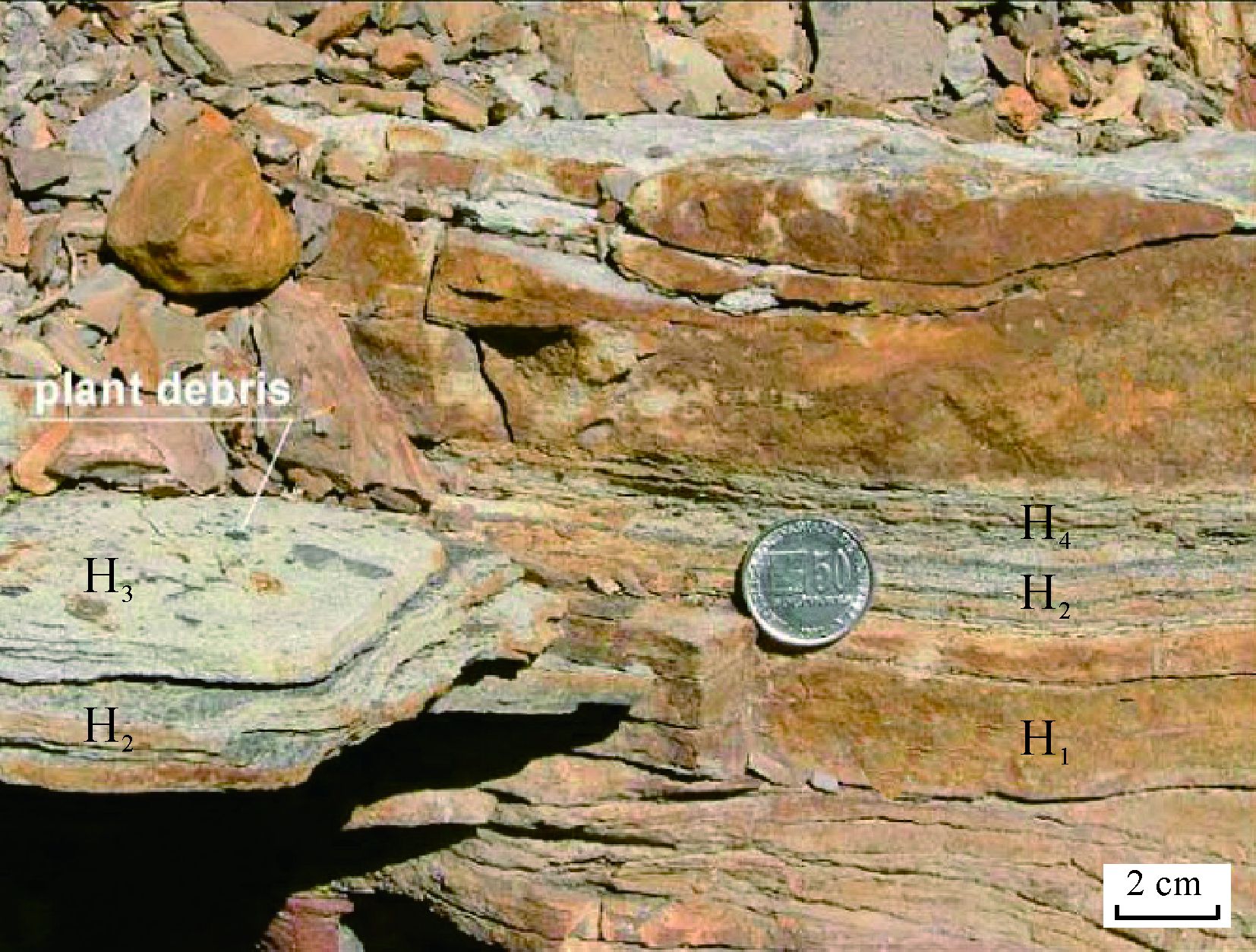
|
| 图 6 委内瑞拉盆地下渐新统陆棚异重岩以混合事件层概念的新解释(原露头照片据Zavala et al.,2011[79]) H1.灰色块状细砂岩,表面被氧化;H2.浅灰色粉砂岩与深灰色粉砂质泥岩互层;H3.灰色块状泥质粉砂岩,富含植物碎屑;H4.灰色泥质粉砂岩,见小型交错层理。 Figure 6 The alternative hybrid event bed interpretation for hyperpycnites in the Upper Oligocene shelfal deposits,Venezuela Basin (The original outcrop image after Zavala et al.,2011[79]) |
当然,浊流在深水斜坡水道中流动,其负载作用会促使斜坡边缘与上斜坡沉积物失稳滑塌,进一步形成次级碎屑流,因而能在近源环境中形成具有类似于混合层的多层段沉积[42, 82]。笔者认为这种沉积现象与沉积物重力流自身的流体转化无关,故在此不作过多探讨。
3.4 不同成因形成混合层的差异不同成因所形成的混合层其岩相特征、垂向组合均存在差异。H1~H5段也不是同时发育,进一步对比发现不同层段发育特征也有所不同,因此呈现多样化的混合层沉积序列。结合前人研究,笔者将不同流体转化所形成的混合层各层段与岩相发育差异具体总结为下表(表 1)。
| 层段 | 单次碎屑流事件的转化 | 单次经典浊流事件的转化 | 单次异重流事件的转化 | |||
| 碎屑流稀释或流体化 | 碎屑流突然减速 | 浊流侵蚀底床泥岩 | 浊流逐渐减速 | 上倾方向水道改道 | 上浮力作用 | |
| H1 | 块状、正粒序层理发育 | 层薄,块状层理发育,贫泥 | 块状层理、正粒序层理,偶见漂浮状泥砾 | 块状层理、正粒序层理 | 层厚,块状、正粒序变层理发育,贫泥 | 复合粒序层理、块状层理发育,细砂岩为主 |
| H2 | 层薄 | 不发育 | 层薄 | 层薄 | 较少见 | 层薄 |
| H3 | 异源砾石或泥砾石,或含炭屑和有机质 | 异源砾石或泥砾石,或含炭屑和有机质 | 内源泥砾、泥岩撕裂屑,不含有机质 | 不含碎屑颗粒,杂砂岩 | 内源泥砾,杂基含量高 | 层薄,泥质粉砂岩,富含炭屑和有机质 |
| H4 | 层薄,Bouma层序Tc段、Td段 | 不发育 | 层薄,Bouma层序Tc段、Td段 | 层薄,Bouma层序Tc段、Td段 | 不发育 | 层薄,间或发育Bouma层序Tc段、Td段 |
| H5 | 半远洋沉积 | 半远洋沉积 | 半远洋沉积 | 半远洋沉积 | 半远洋沉积 | 半远洋沉积 |
通过前人对于多个盆地发育的混合层事件层统计,单次流体事件所形成的混合层厚度最薄为0.05 m,最厚可达10 m,其中绝大多数混合层厚度为1~2 m,反映了单次流体转化的沉积过程。而在混合层极为发育的扇体中多期混合层垂向叠置厚度可达数十米[39, 41]。单次流体形成的混合层在不同位置各层段厚度不同,但主体上沉积厚度向盆地方向减小,碎积岩部分向盆地方向尖灭,从而由混合层过渡为浊积岩(图 7)。
与碎屑流转化相关的混合层沉积通常发育于近源粗粒三角洲(即扇三角洲、近岸水下扇)沉积中,与陆源碎屑流直接入水后不断稀释和转化相关[47]。在深水沉积环境中,斜坡失稳或者三角洲前缘滑塌形成的碎屑流也会发生流体转化,一般在海底扇远端形成混合层沉积。这可能与流体较强的流动能力及过路不沉积有关[44]。
与浊流和异重流转化相关的混合层沉积通常发育于海底扇、舌状体的侧缘或者远端非水道等非限制性环境中(图 7a,b)[39, 48, 83]。而海底水道侧缘、水道-舌状体的过渡区域也存在混合层发育的可能性[72]。
与此同时,限制性内斜坡和海底负向地貌致使浊流侵蚀、减速、拐弯或者折回,均会促使紊流性质减弱,继而产生次级碎屑流,最终形成混合重力流沉积(图 7c,d)[69, 84-87]。
5 混合事件层的研究意义及方向 5.1 混合层的沉积学意义混合事件层的发现为具有碎屑流和浊流双重沉积特征的流体转化沉积提供了更为合理的成因解释,同时也极大推动了重力流的流变学、流体转化及沉积过程等研究的发展。为更好解释混合事件沉积的成因机理,多种浊流与碎屑流的转化模式不断提出和完善,大量水槽模拟实验针对流体转化过程进行了可行性论证。与混合层相关的混合重力流或过渡性重力流也逐渐被人们所熟知,通过现代海底监测发现其在深水盆地具有较强的流动能力,其流动距离长达成百甚至上千公里[40-41]。
混合层的形成常与海底扇体的形成、陆坡不均衡状态以及海底复杂的地貌特征相关[39]。因此对于混合层沉积特征、平面展布以及垂向叠置样式研究对于研究海底扇沉积演化、陆坡均衡状态的转变以及深水限制性重力流的沉积过程均有重要的意义。
5.2 混合层的油气意义混合事件层H1段纯净砂岩杂基含量低,物性相对较好,可作为良好的油气储层[88]。而H3段杂砂岩因其黏土质杂基含量高、物性相对较差,因此通常形成储层间的隔层[89-90]。混合层广泛分布于海底扇远端的沉积环境中,因此混合事件层的发现有利于进一步扩大深水油气勘探范围。例如,北海油田中部古近系海底扇、墨西哥湾油田古近系Wilcox组海底扇所发育的混合层均是目前主力产层[62, 83]。通过混合事件层的发育位置、几何形态特征的研究,结合多井精细对比,能够表征和刻画深水储层的非均质性,从而达到预测有利砂体的目的。
墨西哥湾盆地许多深水油气储层也发育于其北斜坡的一系列盐底辟作用形成的微型盆地中[69, 91]。当浊流进入这种限制性盆地中,在盆地边缘通常能够形成混合事件层沉积。因此对于限制性盆地中混合层形态与规模的精细研究,为其边缘寻找有利油气储层提供有利的依据。此外,混合事件层发育样式、岩石学、物性特征以及空间发育形态对于油气藏采收率、波及系数也有着重要影响,因此近年来也逐渐受到了油藏工程师的重视[88]。
5.3 下一步研究方向混合事件层的发现对于流体转化机制的研究具有深远的影响,同时开创了深水重力流的空间流变学差异性研究先河。但是,目前仍需要大量深水柱样和野外露头证据实例证明其存在的普遍性,并结合水槽实验、数值模拟对不同成因解释进一步验证。此外,应当建立地球物理资料识别混合事件层的技术方法。
目前我国在混合层研究方面仍然是一片空白,流体转化机制相关研究也较为匮乏。根据混合层沉积特征和发育位置,笔者认为其在陆相湖盆重力流沉积体系中也具备有利的形成条件。在以往的研究过程中,我们通常笼统地把岩性突变界面上下的沉积物分开研究,认为它们属于不同的重力流事件。然而,它们完全可能是同期流体事件在流体转化作用下形成的不同性质的沉积物。这需要我们通过精细岩芯观察、多井小层对比,对重力流岩相特进行重新认识。混合层空间展布对于湖泊浊积砂体、扇三角洲与近岸水下扇远端储层构型特征、重力流砂体连通性具有重要的影响,同时也为湖泊重力流的流体转化、沉积过程及重力流成因的新解释提供了新思路。
6 结论(1) 混合事件层是与单次重力流的流体转化相关的沉积产物。其沉积序列类似于浊积岩的Bouma序列,具有正韵律的特征,主要由“五段式”组成,即纯净砂岩段(H1)、条带状砂岩段(H2)、黏性碎积岩段(H3)、波纹层理段(H4)以及块状泥岩段(H5),但一般发育不完整。混合层内部通常存在明显的岩性界面,反映了同期流体在流体转化过程中流变学性质发生改变,其中块状(或递变层理)砂岩(H1)、(黏土)杂基支撑的块状杂砂岩(H3)以及块状泥岩(H5)的垂向岩相组合是混合事件层的重要识别标志。
(2) 与碎屑流相关的流体转化中,一次碎屑流事件可在流动过程中稀释(或流体化)或突然减速形成混合层沉积。与浊流相关的流体转化中,一次浊流事件在流动过程中可通过侵蚀下伏泥岩、流体逐渐减速或者流体改道作用等多种因素形成混合层沉积。不同成因形成的混合事件层其沉积特征存在差异。
(3) 混合事件层发育于重力流为主的扇三角洲内部、海底扇和水道与舌状体过渡区、舌状体侧缘、远端及限制性微型盆地的边缘地区。单期混合层的厚度一般为1~2m,而多期混合层垂向叠置厚度可则达数十米。
(4) 混合事件层研究能够丰富和完善重力流流体转化过程、重力流沉积物空间流变学性质,为沉积物重力流流体转化沉积提供更为准确的成因解释。同时其相关研究也进一步推动了储层表征和非均质性研究,为深水油气勘探开发提供了新思路。
致谢: 笔者在撰写此文之前,曾向利兹大学地球与环境学院的William McCaffrey教授请教混合事件层成因的相关问题,受益良多。在此对他的慷慨帮助和悉心指导特表感谢!| [1] | Kuenen P H, Migliorini C I. Turbidity currents as a cause of graded bedding[J]. The Journal of Geology, 1950 , 58 (2) : 91 –127. DOI: 10.1086/625710 |
| [2] | Bouma A H. Sedimentology of Some Flysch Deposits:A Graphic Approach to Facies Interpretation[M]. Amsterdam: Elsevier, 1962: 168. |
| [3] | Stow D A V, Shanmugam G. Sequence of structures in fine-grained turbidites:comparison of recent deep-sea and ancient flysch sediments[J]. Sedimentary Geology, 1980 , 25 (1/2) : 23 –42. |
| [4] | Lowe D R. Sediment gravity flows:their classification and some problems of application to natural flows and deposits[C]//Doyle L J, Pilkey O H. Geology of Continental Slopes. Tulsa:Society of Economic Paleontologists and Mineralogists Special Publication, 1979, 27:75-82. |
| [5] | Lowe D R. Sediment gravity flows; Ⅱ, depositional models with special reference to the deposits of high-density turbidity currents[J]. Journal of Sedimentary Research, 1982 , 52 (1) : 279 –297. |
| [6] | Massari F. Resedimented conglomerates of a Miocene fan-delta complex, Southern Alps[M]//Koster E H, Steel R J. Sedimentology of Gravels and Conglomerates. Italy:CSPG Special Publications, 1984, 10:259-278. |
| [7] | Mutti E, Tinterri R, Benevelli G, et al. Deltaic, mixed and turbidite sedimentation of ancient foreland basins[J]. Marine and Petroleum Geology, 2003 , 20 (6/7/8) : 733 –755. |
| [8] | Postma G, Nemec W, Kleinspehn K L. Large floating clasts in turbidites:a mechanism for their emplacement[J]. Sedimentary Geology, 1988 , 58 (1) : 47 –61. DOI: 10.1016/0037-0738(88)90005-X |
| [9] | Sohn Y K. On traction-carpet sedimentation[J]. Journal of Sedimentary Research, 1997 , 67 (3) : 502 –509. |
| [10] | Cartigny M J B, Eggenhuisen J T, Hansen E W M, et al. Concentration-dependent flow stratification in experimental high-density turbidity currents and their relevance to turbidite facies models[J]. Journal of Sedimentary Research, 2013 , 83 (12) : 1046 –1064. |
| [11] | Postma G, Cartigny M, Kleverlaan K. Structureless, coarse-tail graded Bouma Ta formed by internal hydraulic jump of the turbidity current?[J]. Sedimentary Geology, 2009 , 219 (1/2/3/4) : 1 –6. |
| [12] | Postma G, Kleverlaan K, Cartigny M J B. Recognition of cyclic steps in sandy and gravelly turbidite sequences and consequences for the Bouma facies model[J]. Sedimentology, 2014 , 61 (7) : 2268 –2290. DOI: 10.1111/sed.12135 |
| [13] | Postma G, Cartigny M J B. Supercritical and subcritical turbidity currents and their deposits:a synthesis[J]. Geology, 2014 , 42 (11) : 987 –990. DOI: 10.1130/G35957.1 |
| [14] | Mulder T, Alexander J. The physical character of subaqueous sedimentary density flows and their deposits[J]. Sedimentology, 2001 , 48 (2) : 269 –299. DOI: 10.1046/j.1365-3091.2001.00360.x |
| [15] | Shanmugam G. Deep-water processes and facies models:implications for sandstone petroleum reservoirs[M]. Amsterdam: Elsevier, 2006: 476. |
| [16] | 李林, 曲永强, 孟庆任, 等. 重力流沉积:理论研究与野外识别[J]. 沉积学报, 2011 , 29 (4) : 677 –688. [ Li Lin, Qu Yongqiang, Meng Qingren, et al. Gravity flow sedimentation:theoretical studies and field identification[J]. Acta Sedimentologica Sinica, 2011 , 29 (4) : 677 –688. ] |
| [17] | Shanmugam G. New Perspectives on Deep-Water Sandstones[M]. Amsterdam: Elsevier, 2012: 1-488. |
| [18] | Talling P J, Masson D G, Sumner E J, et al. Subaqueous sediment density flows:depositional processes and deposit types[J]. Sedimentology, 2012 , 59 (7) : 1937 –2003. DOI: 10.1111/sed.2012.59.issue-7 |
| [19] | Talling P J, Malgesini G, Felletti F. Can liquefied debris flows deposit clean sand over large areas of sea floor? Field evidence from the Marnoso-arenaccea Formation, Italian Apennines[J]. Sedimentology, 2013 , 60 (3) : 720 –762. DOI: 10.1111/j.1365-3091.2012.01358.x |
| [20] | 鲜本忠, 安思奇, 施文华. 水下碎屑流沉积:深水沉积研究热点与进展[J]. 地质论评, 2014 , 60 (1) : 39 –51. [ Xian Benzhong, An Siqi, Shi Wenhua. Subaqueous debris flow:hotspots and advances of deep-water sedimention[J]. Geological Review, 2014 , 60 (1) : 39 –51. ] |
| [21] | Shanmugam G. High-density turbidity currents; are they sandy debris flows?[J]. Journal of Sedimentary Research, 1996 , 66 (1) : 2 –10. DOI: 10.1306/D426828E-2B26-11D7-8648000102C1865D |
| [22] | Shanmugam G. The Bouma Sequence and the turbidite mind set[J]. Earth-Science Reviews, 1997 , 42 (4) : 201 –229. DOI: 10.1016/S0012-8252(97)81858-2 |
| [23] | Shanmugam G. Ten turbidite myths[J]. Earth-Science Reviews, 2002 , 57 (3/4) : 311 –341. |
| [24] | Shanmugam G. Transport mechanisms of sand in deep-marine environments:insights based on laboratory experiments-discussion[J]. Journal of Sedimentary Research, 2011 , 81 (11) : 841 . DOI: 10.2110/jsr.2011.67 |
| [25] | Dasgupta P. Sediment gravity flow-the conceptual problems[J]. Earth-Science Reviews, 2003 , 62 (3/4) : 265 –281. |
| [26] | 李云, 郑荣才, 朱国金, 等. 沉积物重力流研究进展综述[J]. 地球科学进展, 2011 , 26 (2) : 157 –165. [ Li Yun, Zheng Rongcai, Zhu Guojin, et al. Reviews on sediment gravity flow[J]. Advances in Earth Science, 2011 , 26 (2) : 157 –165. ] |
| [27] | 李存磊, 任伟伟, 唐明明. 流体性质转换机制在重力流沉积体系分析中应用初探[J]. 地质论评, 2012 , 58 (2) : 285 –296. [ Li Cunlei, Ren Weiwei, Tang Mingming. Preliminary study on gravity flow depositional system based on fluid properties conversion theory[J]. Geological Review, 2012 , 58 (2) : 285 –296. ] |
| [28] | Fisher R V. Flow transformations in sediment gravity flows[J]. Geology, 1983 , 11 (5) : 273 –274. DOI: 10.1130/0091-7613(1983)11<273:FTISGF>2.0.CO;2 |
| [29] | Smith G A, Lowe D R. Lahars:volcano-hydrologic events and deposition in the debris flow-hyperconcentrated flow Continuum[C]//Fisher R V, Smith G A. Sedimentation in Volcanic Settings. Italy:SEPM Special Publication, 1991:1-5. |
| [30] | Hampton M A. The role of subaqueous debris flow in generating turbidity currents[J]. Journal of Sedimentary Research, 1972 , 42 (4) : 775 –793. |
| [31] | Al-Siyabi H A. Sedimentology and stratigraphy of the early Pennsylvanian Upper Jackfork interval in the Caddo valley quadrangle, Clark and Hot Spring counties, Arkansas[D]. Golden, Colorado:Colorado School of Mines, 1998:272. |
| [32] | Marr J G, Harff P A, Shanmugam G, et al. Experiments on subaqueous sandy gravity flows:the role of clay and water content in flow dynamics and depositional structures[J]. Geological Society of America Bulletin, 2001 , 113 (11) : 1377 –1386. DOI: 10.1130/0016-7606(2001)113<1377:EOSSGF>2.0.CO;2 |
| [33] | Mohrig D, Marr J G. Constraining the efficiency of turbidity current generation from submarine debris flows and slides using laboratory experiments[J]. Marine and Petroleum Geology, 2003 , 20 . |
| [34] | Waltham D. Flow transformations in particulate gravity currents[J]. Journal of Sedimentary Research, 2004 , 74 (1) : 129 –134. DOI: 10.1306/062303740129 |
| [35] | Felix M, Peakall J. Transformation of debris flows into turbidity currents:mechanisms inferred from laboratory experiments[J]. Sedimentology, 2006 , 53 (1) : 107 –203. DOI: 10.1111/sed.2006.53.issue-1 |
| [36] | Felix M, Leszczyński S, Šlaczka A, et al. Field expressions of the transformation of debris flows into turbidity currents, with examples from the Polish Carpathians and the French Maritime Alps[J]. Marine Petroleum Geology, 2009 , 26 (10) : 2011 –2020. DOI: 10.1016/j.marpetgeo.2009.02.014 |
| [37] | Weimer P, Slatt R M. Introduction to the petroleum geology of deepwater setting[M]. , 2007: 111. |
| [38] | Remacha E, Fernandez L P. High-resolution correlation patterns in the turbidite systems of the Hecho Group (South-Central Pyrenees, Spain)[J]. Marine and Petroleum Geology, 2003 , 20 (6/7/8) : 711 –726. |
| [39] | Haughton P, Davis C, McCaffrey W, et al. Hybrid sediment gravity flow deposits-Classification, origin and significance[J]. Marine and Petroleum Geology, 2009 , 26 (10) : 1900 –1918. DOI: 10.1016/j.marpetgeo.2009.02.012 |
| [40] | Talling P J, Wynn R B, Masson D G, et al. Onset of submarine debris flow deposition far from original giant landslide[J]. Nature, 2007 , 450 (7169) : 541 –544. DOI: 10.1038/nature06313 |
| [41] | Talling P J. Hybrid submarine flows comprising turbidity current and cohesive debris flow:deposits, theoretical and experimental analyses, and generalized models[J]. Geosphere, 2013 , 9 (3) : 460 –488. DOI: 10.1130/GES00793.1 |
| [42] | McCaffrey W, Kneller B. Process controls on the development of stratigraphic trap potential on the margins of confined turbidite systems and aids to reservoir evaluation[J]. AAPG Bulletin, 2001 , 85 (6) : 971 –988. |
| [43] | Haughton P D W, Barker S P, McCaffrey W D. "Linked" debrites in sand-rich turbidite systems-origin and significance[J]. Sedimentology, 2003 , 50 (3) : 459 –482. DOI: 10.1046/j.1365-3091.2003.00560.x |
| [44] | Hodgson D M. Distribution and origin of hybrid beds in sand-rich submarine fans of the Tanqua depocentre, Karoo Basin, South Africa[J]. Marine and Petroleum Geology, 2009 , 26 (10) : 1940 –1956. DOI: 10.1016/j.marpetgeo.2009.02.011 |
| [45] | Ricci Lucchi F. Turbidite dispersal in a Miocene deep-sea plain:the Marnoso Arenacea of the northern Apennines[J]. Geologie en Mijnbouw, 1978 , 57 : 559 –576. |
| [46] | Ricci Lucchi F, Valmori E. Basin-wide turbidites in a Miocene, over-supplied deep-sea plain:a geometrical analysis[J]. Sedimentology, 1980 , 27 (3) : 241 –270. DOI: 10.1111/sed.1980.27.issue-3 |
| [47] | Sohn Y K. Depositional processes of submarine debris flows in the Miocene fan deltas, Pohang Basin, SE Korea with special reference to flow transformation[J]. Journal of Sedimentary Research, 2000 , 70 (3) : 491 –503. DOI: 10.1306/2DC40922-0E47-11D7-8643000102C1865D |
| [48] | Talling P J, Amy L A, Wynn R B, et al. Beds comprising debrite sandwiched within co-genetic turbidite:origin and widespread occurrence in distal depositional environments[J]. Sedimentology, 2004 , 51 (1) : 163 –194. DOI: 10.1111/sed.2004.51.issue-1 |
| [49] | Talling P J, Amy L A, Wynn R B. New insight into the evolution of large-volume turbidity currents:comparison of turbidite shape and previous modelling results[J]. Sedimentology, 2007 , 54 (4) : 737 –769. DOI: 10.1111/sed.2007.54.issue-4 |
| [50] | Talling P J, Amy L A, Wynn R B, et al. Evolution of turbidity currents deduced from extensive thin turbidites:marnoso-arenacea Formation (Miocene), Italian Apennines[J]. Journal of Sedimentary Research, 2007 , 77 (3) : 172 –196. DOI: 10.2110/jsr.2007.018 |
| [51] | Amy L A, Talling P J, Peakall J, et al. Bed geometry used to test recognition criteria of turbidites and (sandy) debrites[J]. Sedimentary Geology, 2005 , 179 (1/2) : 163 –174. |
| [52] | Amy L A, Talling P J. Anatomy of turbidites and linked debrites sandstones based on long distance (120×30km) bed correlation, Marnoso Arenacea Formation, Northern Apennines, Italy[J]. Sedimentology, 2006 , 53 (1) : 161 –212. DOI: 10.1111/sed.2006.53.issue-1 |
| [53] | Talling P J, Allin J, Armitage D A, et al. Key future directions for research on turbidity currents and their deposits[J]. Journal of Sedimentary Research, 2015 , 85 (2) : 153 –169. DOI: 10.2110/jsr.2015.03 |
| [54] | Amy L A, Talling P J, Edmonds V O, et al. An experimental investigation of sand-mud suspension settling behaviour:implications for bimodal mud contents of submarine flow deposits[J]. Sedimentology, 2006 , 53 (6) : 1411 –1434. DOI: 10.1111/sed.2006.53.issue-6 |
| [55] | Sumner E J, Talling P J, Amy L A. Deposits of flows transitional between turbidity current and debris flow[J]. Geology, 2009 , 37 (11) : 991 –994. DOI: 10.1130/G30059A.1 |
| [56] | Baas J H, Best J L, Peakall J, et al. A phase diagram for turbulent, transitional and laminar clay suspension flows[J]. Journal of Sedimentary Research, 2009 , 79 (4) : 162 –183. DOI: 10.2110/jsr.2009.025 |
| [57] | Baas J H, Best J L, Peakall J. Depositional processes, bedform development and hybrid bed formation in rapidly decelerated cohesive (mud-sand) sediment flows[J]. Sedimentology, 2011 , 58 (7) : 1953 –1987. DOI: 10.1111/sed.2011.58.issue-7 |
| [58] | Breien H, De Blasio F V, Elverhøi A, et al. Transport mechanisms of sand in deep-marine environments-insights based on laboratory experiments[J]. Journal of Sedimentary Research, 2010 , 80 (11) : 975 –990. DOI: 10.2110/jsr.2010.079 |
| [59] | Lowe D R, Guy M. Slurry-flow deposits in the Britannia Formation (Lower Cretaceous), North Sea:a new perspective on the turbidity current and debris flow problem[J]. Sedimentology, 2000 , 47 (1) : 31 –70. DOI: 10.1046/j.1365-3091.2000.00276.x |
| [60] | Lowe D R, Guy M, Palfrey A. Facies of slurry-flow deposits, Britannia Formation (Lower Cretaceous), North Sea:implications for flow evolution and deposit geometry[J]. Sedimentology, 2003 , 50 (1) : 45 –80. DOI: 10.1046/j.1365-3091.2003.00507.x |
| [61] | Blackbourn G A, Thomson M E. Britannia Field, UK North Sea:petrographic constraints on Lower Cretaceous provenance, facies and the origin of slurry flow deposits[J]. Petroleum Geoscience, 2000 , 6 (4) : 329 –343. DOI: 10.1144/petgeo.6.4.329 |
| [62] | Davis C, Haughton P, McCaffrey W, et al. Character and distribution of hybrid sediment gravity flow deposits from the outer Forties Fan, Palaeocene Central North Sea, UKCS[J]. Marine and Petroleum Geology, 2009 , 26 (10) : 1919 –1939. DOI: 10.1016/j.marpetgeo.2009.02.015 |
| [63] | Baas J H, Best J L. Turbulence modulation in clay rich sediment-laden flows and some implications for sediment deposition[J]. Journal of Sedimentary Research, 2002 , 72 (3) : 336 –340. DOI: 10.1306/120601720336 |
| [64] | Haughton P, Davis C, McCaffrey W, et al. Reply to Comment by R. Higgs on 'Hybrid sediment gravity flows deposits-classification, origin and significance[J]. Marine and Petroleum Geology, 2010 , 27 (9) : 2066 –2069. DOI: 10.1016/j.marpetgeo.2010.06.012 |
| [65] | Schwab W C, Lee H J, Twichell D C, et al. Sediment mass-flow processes on a depositional lobe, outer Mississippi Fan[J]. Journal of Sedimentary Research, 1996 , 66 (5) : 916 –927. |
| [66] | Mohrig D, Ellis C, Parker G, Whipple K X, et al. Hydroplaning of subaqueous debris flows[J]. Geological Society of America Bulletin, 1998 , 110 (3) : 387 –394. DOI: 10.1130/0016-7606(1998)110<0387:HOSDF>2.3.CO;2 |
| [67] | Piper D J W, Cochonat P, Morrison M L. The sequence of events around the epicentre of the 1929 Grand Banks earthquake:initiation of debris flows and turbidity current inferred from sidescan sonar[J]. Sedimentology, 1999 , 46 (1) : 79 –97. DOI: 10.1046/j.1365-3091.1999.00204.x |
| [68] | Ito M. Downfan transformation from turbidity currents to debris flows at a channel-to-lobe transitional zone:the lower Pleistocene Otadai Formation, Boso peninsula, Japan[J]. Journal of Sedimentary Research, 2008 , 78 (10) : 668 –682. DOI: 10.2110/jsr.2008.076 |
| [69] | Pyles D R, Jennette D C. Geometry and architectural associations of co-genetic debrite-turbidite beds in basin-margin strata, Carboniferous Ross Sandstone (Ireland):applications to reservoirs located on the margins of structurally confined submarine fans[J]. Marine and Petroleum Geology, 2009 , 26 (10) : 1974 –1996. DOI: 10.1016/j.marpetgeo.2009.02.018 |
| [70] | Lee S H, Jung W Y, Bahk J J, et al. Depositional features of co-genetic turbidite-debrite beds and possible mechanisms for their formation in distal lobated bodies beyond the base-of-slope, Ulleung Basin, East Sea (Japan Sea)[J]. Marine Geology, 2013 , 346 : 124 –140. DOI: 10.1016/j.margeo.2013.09.001 |
| [71] | Magalhaes P M, Tinterri R. Stratigraphy and depositional setting of slurry and contained (reflected) beds in the Marnoso-Arenacea Formation (Langhian-Serravallian) Northern Apennines, Italy[J]. Sedimentology, 2010 , 57 (7) : 1685 –1720. DOI: 10.1111/sed.2010.57.issue-7 |
| [72] | Terlaky V, Arnott R W C. Matrix-rich and associated matrix-poor sandstones:avulsion splays in slope and basin-floor strata[J]. Sedimentology, 2014 , 61 (5) : 1175 –1197. |
| [73] | Mulder T, Syvitski J, Migeon S, et al. Marine hyperpycnal flows:initiation, behavior and related deposits. A review[J]. Marine and Petroleum Geology, 2003 , 20 (6/7/8) : 861 –882. |
| [74] | 谈明轩, 朱筱敏, 朱世发. 异重流沉积过程和沉积特征研究[J]. 高校地质学报, 2015 , 21 (1) : 94 –104. [ Tan Mingxuan, Zhu Xiaomin, Zhu Shifa. Research on sedimentary process and characteristics of hyperpycnal flows[J]. Geological Journal of China Universities, 2015 , 21 (1) : 94 –104. ] |
| [75] | 杨田, 操应长, 王艳忠, 等. 异重流沉积动力学过程及沉积特征[J]. 地质论评, 2015 , 61 (1) : 23 –33. [ Yang Tian, Cao Yingchang, Wang Yanzhong, et al. Sediment dynamics process and sedimentary characteristics of hyperpycnal flows[J]. Geological Review, 2015 , 61 (1) : 23 –33. ] |
| [76] | Talling PJ. On the triggers, resulting flow types and frequencies of subaqueous sediment density flows in different settings[J]. Marine Geology, 2014 , 352 : 155 –182. DOI: 10.1016/j.margeo.2014.02.006 |
| [77] | Girard F, Ghienne J, Rubino J L. Occurrence of hyperpycnal flows and hybrid event beds related to glacial outburst events in a late Ordovician Proglacial delta (Murzuq Basin, SW Libya)[J]. Journal of Sedimentary Research, 2012 , 82 (9) : 688 –708. DOI: 10.2110/jsr.2012.61 |
| [78] | Hürzeler B E, Imberger J, Ivey G N. Dynamics of turbidity current with reversing buoyancy[J]. Journal of Hydraulic Engineering, 1996 , 122 (5) : 230 –236. DOI: 10.1061/(ASCE)0733-9429(1996)122:5(230) |
| [79] | Zavala C, Arcuri M, Meglio M D, et al. A genetic facies tract for the analysis of sustained hyperpycnal flow deposits[C]//Slatt R, Zavala C. Sediment transfer from shelf to deep water-Revisiting the delivery system. AAPG Studies in Geology, 2011, 61:31-51. |
| [80] | Pritchard D, Gladstone C. Reversing buoyancy in turbidity currents:developing a hypothesis for flow transformation and for deposit facies and architecture[J]. Marine and Petroleum Geology, 2009 , 26 (10) : 1997 –2010. DOI: 10.1016/j.marpetgeo.2009.02.010 |
| [81] | Gladstone C, Pritchard D. Patterns of deposition from experimental turbidity currents with reversing buoyancy[J]. Sedimentology, 2010 , 57 (1) : 53 –84. DOI: 10.1111/sed.2009.57.issue-1 |
| [82] | 酒井哲弥, 立石良, 古川絢子. 松江市島根町須々海海岸の中新統牛切層に見られる重力流堆積物(予報)[J]. 島根大学地球資源環境学研究報告, 2007 , 26 : 25 –33. [ Tetsuya S, Ryo T, Ayako F. Gravity flow deposits in the Miocene Ushikiri Formation exposed along the Susumi coast, Matsue, Japan (preliminary note)[J]. Geoscience Report of Shimane University, 2007 , 26 : 25 –33. ] |
| [83] | Kane I A, Pontén A S M. Submarine transitional flow deposits in the Paleogene Gulf of Mexico[J]. Geology, 2012 , 40 (12) : 1119 –1122. DOI: 10.1130/G33410.1 |
| [84] | Barker S P, Haughton P D W, McCaffrey W D, et al. Development of rheological heterogeneity in clay-rich high-density turbidity currents:Aptian Britannia Sandstone Member, U[J]. Journal of Sedimentary Research, 2008 , 78 (2) : 45 –68. DOI: 10.2110/jsr.2008.014 |
| [85] | Patacci M, Haughton P D W, McCaffrey W D. Rheological complexity in sediment gravity flows forced to decelerate against a confining slope, Braux, SE France[J]. Journal of Sedimentary Research, 2014 , 84 (4) : 270 –277. DOI: 10.2110/jsr.2014.26 |
| [86] | Southern S J, Patacci M, Felletti F, et al. Influence of flow containment and substrate entrainment upon sandy hybrid event beds containing a co-genetic mud-clast-rich division[J]. Sedimentary Geology, 2015 , 321 : 105 –122. DOI: 10.1016/j.sedgeo.2015.03.006 |
| [87] | Tinterri R, Tagliaferri A. The syntectonic evolution of foredeep turbidites related to basin segmentation:facies response to the increase in tectonic confinement (Marnoso-arenacea Formation, Miocene, Northern Apennines, Italy)[J]. Marine and Petroleum Geology, 2015 , 67 : 81 –110. DOI: 10.1016/j.marpetgeo.2015.04.006 |
| [88] | Amy L A, Peachey S A, Gardiner A A, et al. Prediction of hydrocarbon recovery from turbidite sandstones with linked-debrite facies:numerical flow-simulation studies[J]. Marine and Petroleum Geology, 2009 , 26 (10) : 2032 –2043. DOI: 10.1016/j.marpetgeo.2009.02.017 |
| [89] | Garland C R, Haughton P D W, King R F, et al. Capturing reservoir heterogeneity in a sand-rich submarine fan, Miller field[C]//Fleet A J, Boldy S A R. Petroleum Geology of Northwest Europe:Proceedings of the 5th Conference. London:Geological Society of London, 1999, 5:1199-1208. |
| [90] | FugelliE M G, Olsen T R. Delineating confined slope turbidite systems offshore mid-Norway:the cretaceous deep-marine lysing Formation[J]. AAPG Bulletin, 2007 , 91 (11) : 1577 –1601. DOI: 10.1306/07090706137 |
| [91] | Pyles D R, Skvitski J P M, Slatt R M. Defining the concept of stratigraphic grade and applying it to stratal (reservoir) architecture and evolution of the slope to basin profile:an outcrop perspective[J]. Marine and Petroleum Geology, 2011 , 28 (3) : 675 –697. DOI: 10.1016/j.marpetgeo.2010.07.006 |
 2016, Vol. 34
2016, Vol. 34



